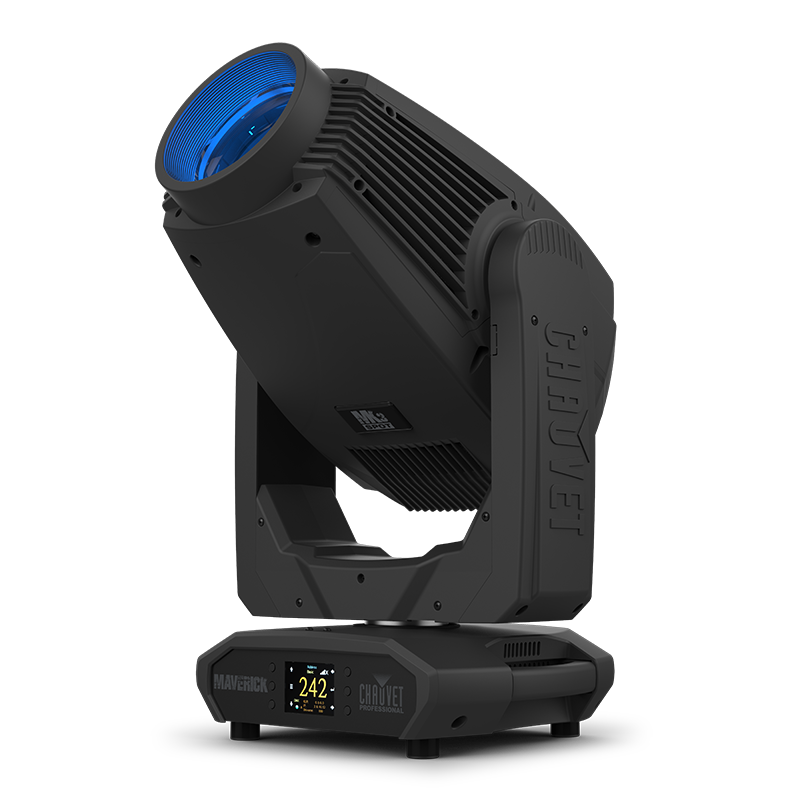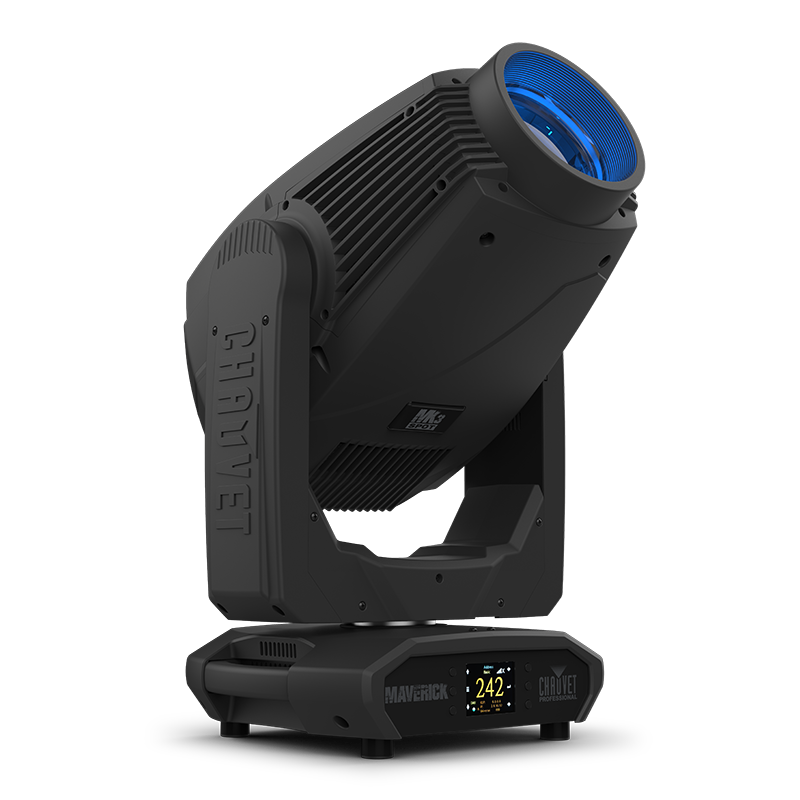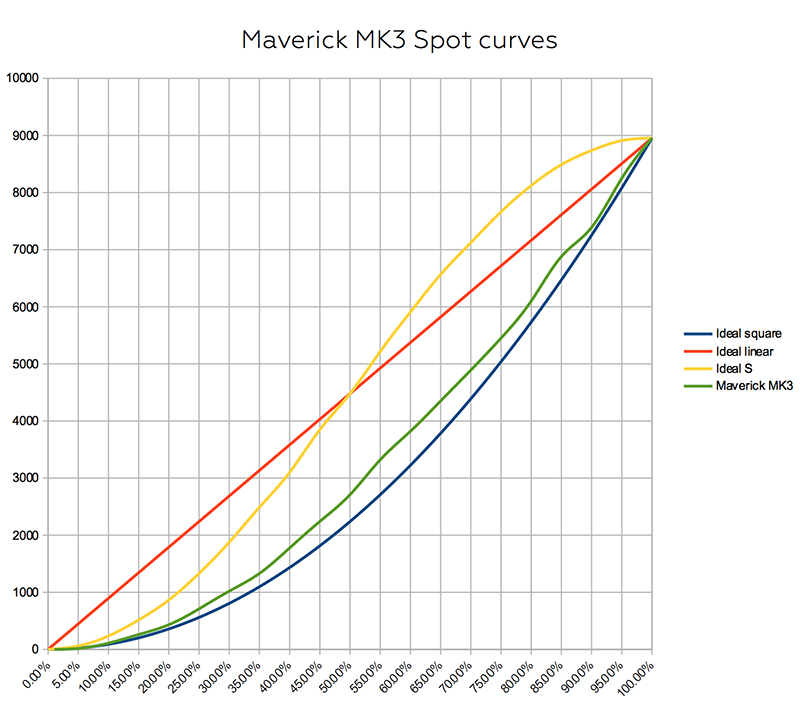
Large-format fixtures have been the last to make the change to LED. Excepting some specialized narrow-beam fixtures, these solid-state semiconductors have supplanted the humble electrical spark jumped between electrodes as the most widespread way of generating the intensity needed to slice through the unrelenting glow of the ubiquitous and oversized video wall.

Light Source, Color, Effects
The effects make the luminaire, however; we as lighting designers are purveyors of looks above all else, and our ability to create these depend heavily upon our various toolsets. Parity having essentially been reached in terms of lux with arc sources, we consider next how many, and of what quality, are the visuals we can create. Today we’ll look at the Maverick MK3 Spot, one of the latest large-format spot fixtures from Chauvet Professional, and consider its merits.
The MK3 Spot is a large light, with a surprisingly small section of the rear of the fixture dedicated to thermal control. The source for this light is an 820 watt white LED array from Appotronics, with a rated color temperature of 7,472 Kelvin, with color temperature out of the lens at 6,850K; a nice crisp white. I measured a final output of 9,530 lux from five meters at 50 percent zoom, after letting the fixture run at full for twenty minutes. This is down from an initial value of 12,510 lux, which represents a thermal drop of 24 percent. Chauvet lists the output lumens at 22,000.
One advantage of using LEDs in spot fixtures is the field evenness, which was certainly evident here: the field was remarkably smooth and even. Dimming was excellent, with a smooth fade to black, and no weird jumps in the range, even in the last few DMX values before blackout. I tested the fixture on the square law curve, which was reasonably close to an ideal curve.
There’s a good selection of strobe effects here, including pulses, random, and synchronous strobes up to 25Hz. The MK3 Spot also does a trick I’ve seen a few other fixtures do — it can run different sections of its LED array separately, which varies the apparent parallax of the source, making a “shifting” motion. Chauvet calls this “Virtual Strobe,” and the user can vary the speed and fade of this effect. To avoid banding for video applications, the PWM is variable, between 600 and 15,000Hz.
Most of the effects on this light are housed on a single removable module immediately past the LED array. This module is a bit of a task to remove, so I’d only attempt this task with the light out of the rig. Closest to the array on this module is the color mixing, a flag assembly of the sort that’s become the norm for subtractive color systems. Color mixing is acceptable, with some unevenness in the beam that I particularly noticed when mixing aqua hues and light greens. All optical systems like this have better and worse locations for the lens assemblies when trying to get even color mixing.
As expected with current blue-pumped white LEDs, reds are the weakest part of the mixed range, so the MK3 Spot comes with a fixed color wheel with six positions plus open to help fill in the gaps. There is, of course, a deep red filter, as well as a CTO filter. There is also a separate “CRI” filter in this light, which in practice looks like a minus green filter, that bumps the CRI up from 75 to 94. This filter is not on the color wheel, it’s on its own completely independent armature. You lose a small amount of light with it in, but it might be worth it in certain color-sensitive applications. A variable CTO filter smoothly adjusts the color temperature of the light down to 3,230K.

Gobos, Zoom, Prisms
Next on this module are the gobos, with three wheels: two wheels with rotating and indexing patterns, and one static wheel. Both rotating wheels have seven gobos plus open, while the static wheel has nine gobos plus open. I appreciate the gobos Chauvet has picked, most of which I haven’t seen before. Our industry reuses gobos constantly and seeing a fixture with new patterns in an ocean of recycled gobos is refreshing. A few colored gobos amongst the usual black and white keep things visually novel. Most of the patterns strongly suggest an aerial role for themselves, but a couple would work well as textures on scenery. Changes between adjacent gobos are fast, while the rotation is smooth down to the very slowest speeds.
The iris is next in line, and features continuously variable sizing, as well the usual selection of effects, including pulses and snaps. Also on the main module is the animation wheel, which features variable insertion (meaning the animation wheel does not have to be fully inserted into the beam path to be operational) as well as continuous rotation in either direction. The pattern is a thick tiger-striped pattern and works well in combination with gobos for creating fire, water, and other organic-looking effects. Focus quality was good, with only minor center-to-edge differences, and the zoom adjusts smoothly from 6° to 55° in less than one second. There is also an auto-focus feature, which was quite effective at keeping things in focus through zoom changes.
After the moving zoom and focus lenses are the frosts and prisms. There are two variable levels of “frost”; the first is a contrast reducer that leaves the edges of gobos intact, but gives everything a pleasing softness. The second is a harder frost that completely eliminates edges, but the major shapes of gobos can still be seen through it. Both frosts can be overlaid and used at the same time. Additionally, there are two rotating and indexing prisms, a five-facet circular one with a square central hole, and a five-facet linear prism. Both provide good image separation, and both can also be overlaid and used at the same time, though frosts will override the prisms if inserted.
The MK3 Spot accepts power via a Seetronic True1-style input, and auto-ranges its input voltage between 100V and 240V. Data in is via 5-pin and 3-pin XLR ins and pass-throughs, and the fixture also accepts DMX via Art-Net, and sACN via EtherCON-style ins and pass-throughs. The fixture is also RDM-compliant and has a built-in antenna for control via W-DMX. Booting from a cold start takes 1:15, and is well-behaved, turning its output off before moving, then coming to its final position before restoring the dimmer. Being aware of how light behaves during reset is something I wish more lighting manufacturers would be aware of and implement — resetting fixtures during shows is something we all have to do.
Pan and tilt locks are included. A color touchscreen is provided for setting fixture options and personality, and rigging is via standard Omega brackets fitted with your choice of mounting hardware. The fixture stands 29.76 inches tall with a base 16.1 by 11.92 inches. It weighs in at 72.9 pounds.
At-A-Glance:
New Competition for Arc-Source Movers
The Chauvet Maverick MK3 Spot exemplifies Chauvet’s continuing efforts to set new standards for LED moving lights. As the industry-wide adoption of LED continues, designers and production houses will require large-format LED fixtures capable of competing with arc sources, and — of course — the increasingly ubiquitous LED video wall. This luminaire stands out with a strong feature set including gobos, dual prisms, wide zoom range and more.
PROS: Bright LED light source, great gobo set
CONS: Some minor unevenness in the color mixing
FEATURES
- Max Wattage: 1,120W
- Color Options: Mixing and color wheel
- Zoom Range: 6-55°
- Pan and Tilt: 540°/270°
- Gobos: Two rotating, one static
- CTO: Variable wheel
- Frost: Thin and thick flags
- Prisms: Circular and linear
STATS
- Light Source: 820W LED engine
- Max Wattage: 1,120W
- Size: 29.8 x 16.1 x 11.92”
- Weight: 72.9 lbs.
- MSRP: $11,503.76
Manufacturer: Chauvet
More Info: www.chauvetprofessional.com


